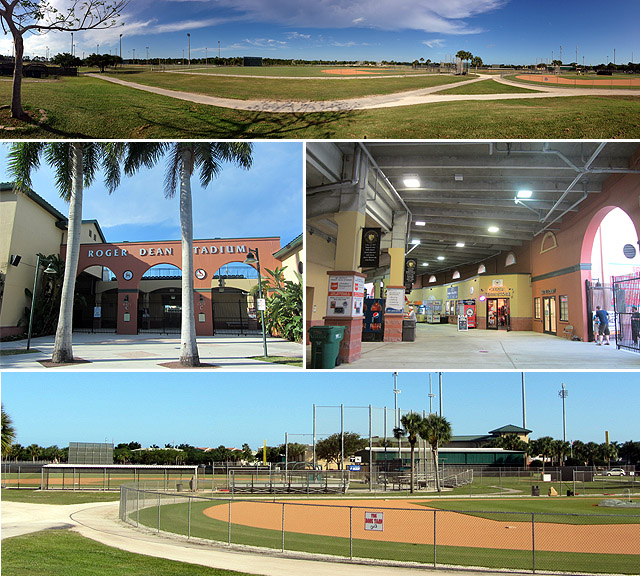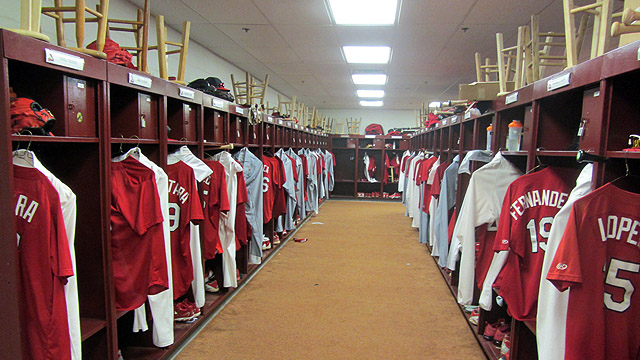At Roger Dean, a season that never ends
For most Minor League teams, the days leading up to the start of the regular season are among the year's busiest. For those who work at Roger Dean Stadium, however, it represents a chance to maybe relax a little bit.
In addition to serving as the home of the Florida State League's Jupiter Hammerheads and Palm Beach Cardinals, Roger Dean Stadium also hosts Spring Training for the parent clubs of both teams (the Miami Marlins and St. Louis Cardinals, respectively). Thus, by the time that the Florida State League season began on April 9, the facility had already welcomed more than 160,000 fans over what amounted to a 29-game Spring Training homestand.
By comparison, and if past seasons are any indication, the Jupiter and Palm Beach teams will combine to draw an estimated 140,000 fans over 140 games (minus a handful of inevitable rainouts) played at Roger Dean Stadium.
I attended April 14's game at Roger Dean Stadium, in which the Hammerheads hosted the Clearwater Threshers on a beautiful, rain-free Tuesday evening. An announced crowd of 927 was on hand to check out the ballgame -- the fan atmosphere was jovial and relaxed but, at times, very, very quiet. It was within this serene environment that I spoke to Mike Bauer, general manager of Roger Dean Stadium. He was happy sit with me for an interview in a section down the third-base line -- it was a rare instance when he had time to do it.
"The thing that you have to know is that, for the six and a half weeks that [the Major League clubs] are here, we're here every day," said Bauer. "The time for us, in preparation for the beginning of the season, is always the most intense. You're getting your final sales in, you're getting the building cleaned up, signs hung, all of that stuff. Then [the Major Leaguers arrive] and you roll in for six straight weeks. So, a lot of my staff went between 49 and 55 days in a row without a day off, and we're talking full days. Spring Training is our breadwinner -- it's where we make our money -- so our focus, our time and energy is all on that."

The sprawling complex includes practice fields, GCL stadiums and top-notch facilities for Major League Spring Training. (Ben Hill/MiLB.com)
|
Everyone who works at Roger Dean Stadium is an employee of Jupiter Stadium Limited, a partnership formed between the St. Louis Cardinals and Miami Marlins. As general manager, Bauer oversees the entire facility. This includes not just the stadium itself, but the entirety of a sprawling 120-acre complex that, in total, includes 12 full-size baseball fields.
During Spring Training, both the Cardinals and the Marlins have their own quad, half-field, three sets of batting cages and three bullpen mounds. These common areas are accessible to fans during Spring Training, so that they can watch players workout and warm up as well as take in Minor League Spring Training games.
"A typical day is you get here around eight," said Bauer. "The [players] are already working -- some of them have been in since 4:30 in the morning. ... So you have to check in with the teams each day, to make sure their needs are met -- our grounds crew guys know how to set up the field exactly to their specifications. A typical day is making sure that everything flows evenly, from the parking lot to the ticket windows to fans getting in the seats to the lines at concessions to the food in the suites. Everybody in their department is doing their job to make it all go flawlessly and my job is to oversee all of that."
This isn't to say that there's not a lot going on once Spring Training ends and the Florida State League begins. As I've written previously, Roger Dean Stadium is "America's Busiest Ballpark." In addition to being the only stadium to host two Minor League teams during the regular season, the Roger Dean backfields also accommodate Cardinals and Marlins extended Spring Training as well as the short-season Rookie-level Gulf Coast League franchises for both organizations. And this isn't to mention the approximately 15 amateur baseball tournaments staged at Roger Dean annually, with each one consisting of somewhere between 15 and 90 separate teams.
But it's all a matter of perspective. Once the Major Leaguers head north, the pace at Roger Dean Stadium returns to something resembling normalcy.
"It's a difficult transition for us to go from 'Go go go go go go go' to 'OK, we made it through' to 'Everybody take three days off' to 'Oh, by the way, the Minor League season starts in four days,'" said Bauer, referencing the adjustment to the rhythms of Florida State League baseball. "Moving from Spring Training to the Florida State League is, in a way, kind of like NASCAR -- we have our Super Bowl in the beginning and then the regular season follows."

A look inside a clubhouse: Roger Dean hosts both the Palm Beach Cardinals and St. Louis' GCL affiliate. (Ben Hill/MiLB.com)
|
And, as part of that transition, the demand for professional baseball at Roger Dean Stadium plummets. This is largely in response to a lower level of play (from Major Leaguers to Class A Advanced prospects), difficult weather (daily summer thunderstorms are a fact of life) and an almost comically overabundant supply of games to choose from.
"It's truly a challenge within the Florida State League, having two teams, because 140 games is a lot of games. You lose a sense of 'Hey, catch 'em all' because we're here every day," said Bauer. "But during the Minor League season we have a chance to let our hair down a little bit, do Kid's Club activities and promotions like barbecue festivals and 'Star Wars Night' and all those things that the families enjoy. Whereas Spring Training is a little more black and white. It's about baseball and the food. That's what it is.
"[In the Florida State League] we don't market an equal number of Palm Beach and Hammerheads games," he continued. "We market the weekends and we market the holidays however they fall, because the arrangement is that, although they're two separate teams, financially it's all one pot. [The Marlins and Cardinals] go in together and split everything down the middle."
And so it will go, until the Florida State League season ends in early September.
"It doesn't stop, because as soon as the season is over, we're writing the budgets," said Bauer. "And then you get to October and we're one month away from season tickets going on sale for Spring Training and then you're starting all over again. It truly is a year-round baseball business for us."
Benjamin Hill is a reporter for MiLB.com and writes Ben's Biz Blog. Follow Ben on Twitter @bensbiz.
